|
|
Castle Schönbrunn: Former Imperial Residence
In any case, the castle Schönbrunn belongs to the highlights of the visitor if never been in Vienna before. Combined with the park complex and the abundance of worlds, the castle already satisfies several requirements at once. It is an original scene of the imperial life. Generalities about Visiting SchönbrunnWhen we viewed the castle Schönbrunn, we were very impressed by the bigness of the castle and the dimensions in which the palace garden extended with its individual gardens and botanic houses. It is very easy to get there, as the station where to get off is the same named station "Schloss Schönbrunn", no matter if by bus, subway or tram. The footway from the subway up to the castle takes approximately 10 minutes. But one should consider previously that, depending on how much one wants to see, a few hours should be planned for viewing the castle Schönbrunn. 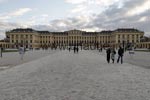
Beside the rooms of the castle there are also a few sightseeings to view in the park. Within the huge palace garden , there are some additional smaller gardens and houses with special worlds. Thus, there is for example, beside the animal garden also a botanical garden, beside the desert house also a palm house and a maze with a labyrinth. Although one probably does not plan to see all at once, it is in any case recommendable to start with comfortable shoes, as the distances within the whole complex are very large. For the beginning we decided to view first the interior of the castle Schönbrunn. Something about the History of the Castle SchönbrunnBef0re visiting the castle Schönbrunn, one is really amazed by hearing that the whole castle Schönbrunn with its park complex and individual sightseeings belongs since the year 1997 to the world cultural heritage of the UNESCO. Thus, the dapper and well-looked after castle complex with its whole history highly protrudes the significance of a cultural monument of Austrian history. The origin of the castle Schönbrunn and the buildings on this plaza goes back up th the medieval times. In the last third of the 16th century, the Emperor Maximilan II. acquired the territory of monasterial property and used it apart from the breeding of domestic and exotic game animals and kinds of birds, also as a hunting ground. The actual name Schönbrunn was originates in teltion to a font that the son of the Emperor presumably found. The fountain built around this font was named Schönbrunn. The whole estate was mainly used as a hunting residence until around the year 1642 when a pleasure palace was built and named Schönbrunn. 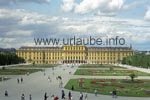
Not until the end of the 17th century, the conversion to the castle took place by Leopold I. He ordered the plans for a summer residence to the famous arquitect Johann Bernhard Fischer von Erlach. Even though the first visual suggestion for the castle Schönbrunn resulted to be a little unspectacular, in the year 1696, the construction works could be started that also included the partly destroyed base walls of the pleasure palace that was originally standing there and damaged during the siege of the Turks. Not until the governance period of Maria Theresia the construction works of the castle complex regained momentum in the years 1742/43, that until that time were only partly finished. Maria Theresia had the castle complex rearranged and expand so that it gained a spacial political significance nt nly for private but also for representative purposes. At that time, the castle Schönbrunn got the shape the way we know the complex today, even though the colour and the ornamentation of the cladding was changed in the 18th century to the way it is today. What should be specially mentioned is the castle Schönbrunn with its oldest animal garden of the world, that was originated in the year 1752. The whole garden complex did not get its shape until approximately 20 years later. In laborious beautification efforts, flower beds were arranged, fountains built and the gloriette on a hill in front of the castle in the year 1775. In the year 1780, Maria Theresia could experience the laboriously arranged building after its last perfection shortly before she died. What is specially interesting and fascinating to the visitors of the castle Schönbrunn are the chambers of the imperial couple Franz Joseph and Sisi, today known by almost everybody dduring the christmas season. When Franz Joseph was born in the year 1830 in the castle Schönbrunn, his parents resided in the eastern wing of the castle, so tht in the later years, he moved to the western wing. The castle Schönbrunn, considered as his preferred residence during his life, became with the accession to the throne in the year 1848 also an important meeting place for imperial audiences. From the year 1854, also the Empress Sisi moved to her own chambers in the western wing of the castle. Viewing the Castle SchönbrunnThose who want to view the castle Schönbrunn can chose between two tours. Both start each at the west wing of the castle, but the number of chambers to view is different. The so-called imperial-tour which we choosed in autumn 2007 includes a total of 26 rooms, therefrom 22 ceremonial rooms, and ends in the middle wing of the castle. The so-called grand-tour leads further from there and one can view a total of 40 chambers. It is possible to borrow some headphones for all the tours for the case one does not want to read the information referred to each of the rooms in the brochure one gets free of charge. 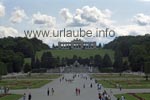
Unfortunately, it was not allowed to make some pictures in the interior of the castle. Even thugh mny people were on their way during the viewing, the crowds spread to some extend in the huge chambers. Thus, the lack of space was quite moderated and not to be compared to the Sisi Museum, where one partly had to squeeze one's way through the narrow alleyways. The viewing of the chambers started in the 1st floor with the so-called guard room, where the bodyguard of the Emperor Franz stayed. Before getting to his private chambers, first, one had to walk through the audience waiting room. The writing room and the bedroom of the Emperor were quite without pomp and simple. The chambers are subsequently arranged so that one can view them in sequence until arriving to the imperial bedroom at which the chambers of the Empress Elisabeth were connected. The rooms thereafter served as dining room or were representative rooms with a beautiful view to the palace gardens. 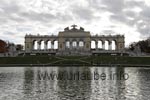
The actually amazing thing of this viewing is the combination in which a stately impressive arquitecture, contemporary furniture and interieur in front of a fascinating coulisse with a view to the palace garden seems to revive the not less impressive imperial history of Austria right in this moment when one is there. The small and/or big gallery was also very impressive. Here, the private and also official festivities of the imperial family took place. In the big gallery with a length of 40 metres and a width of almost 10 metres that was surrounded at one side by a big front window and a mirror front at the other side, one could very closely relive a touch of the pompous proms of Sisi. If a Viennese Waltz would have played there, then the festive atmosphere would have been perfectly inscened in the gallery. Unfortunately, we cannot judge if the chambers of the grand tour that leads through the whole castle differ significantly from the ones we saw in the imperial tour. In order to get an impression of the atmosphere and an insight in the courtly way of life of the Emperor Franz Joseph I. and the Empress Sisis, the smaller tour was sufficient in any case, specially considering that we still wanted to have a walk in the palace garden and that the whole excursion with the visit of the palm house, desert house, ect. was going to be exhausting. As I already mentioned in the beginning, it is worthwhile to get previously an overview of the offers concerning the castle Schönbrunn and to limit one's targets respectively, otherwise it will be much too exhausting, specially with children. The Palace GardenBy walking through the planted flower beds of the park, one first does not imagine that the whole area of the palace garden extends in a legnth and width ofnearly one kilometre each. The view to the backside of the castle Schönbrunn and the gloriette that enthrones on a small hill are more thn imposing. Thus, our way also led us first up to the upheaval that from looks from down as a small hill but during the march upwards it results to be very tough. 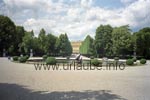
Our view fell to widely arranged lawns and abundantly adorned fountains. But anytime we wanted to make a picture,a lot of people were in the range of vision. It seemed that many visitors wanted to climb up the small branched paths to the gloriette. Thus, we were not very surprised when we did not get any seat in the small café in the gloriette, that, with a lot of view windows, offered an attractive possibility to rest. But the seats were positioned very closely together and the lack of cosiness in the overfull room was not very inviting, as any few minutes the door was opened and people entered the room for some metres in order to look for a seat. But at the front of the café where enough benches from which we could have a look down to the castle Schönbrunn. Unfortunately, the view to the geometrically arranged flower beds was a little trist in autumn time and the cold wind was blowing on the hill that was free standing from all sites so that we got really cold. Under these circumstances, it was hard to imagine the imposing colourfulness that apparently appears in the summer time. It is surely worthwhile to visit the castle Schönbrunn in the summer time when everything blossoms but then one surely has to count with more visitors respectively than there are in the autumn season. The Palm HouseFrom the gloriette, we first walked the hill back down in order to loaf alongside the eastern prt of the park. The paths are very neatly arranged and in between, we come across to some joggers here and there, who apparently are not deterred by the tourist crowds. The palm house with its iron construction of the years 1820/21 makes a very futuristic impression considering the time it had been originated, but it also forms a very peculiar coulisse with the surrounding trees and bushes cut in shape. One should not expect to much from the interior of the palm house. It is indeed possible to collect certain amounts of plants in a length f 123 metres, but this is not comparable to the big palm gardens. 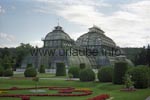
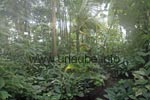
In total, there are three different climate zones that can be browsed. By entering the palm house, the abundance of little decoration pumpkins appeared a little odd, as I actually expected some large and bright plants. We saw them then in the tropical area of the palm house. Here, one has to be careful that one's camera would not get steamy. Here, the palms could grow to a stately height of 28 metres until touching the ceiling. In the two other areas where plants of medium and colder areas were exhibited respectively, there were also a lot of flowering plants to see that reminded me on the domestic garden plants. Those who view the palm huse of the castle Schönbrunn should not expect to see any originally and exotic plants. Those who have only small chances to see more exotic plants during the holidays or simply want to see something different during the visit of the palace gardens will have here a small diversion. But my feeling is that the diversion here is really quite small, and those who want to save some money in consideration of all the entrance fees there are to pay, can confidently abstain from this attraction. The Desert House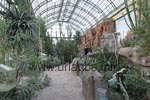
In the desert house right in front of the palm house, I first had the same feeling. The flora with the many different cacti is surely impressive if one has only few chances to see such things somewhere else. But if one considers that the Emperor Franz Joseph I. had this glass house built that was finally finished in the year 1904 in order to give the plants coming from Australia and Africa a good chance to grow, this house gets something interesting. Today, one can walk through subterranean alleyways with glass inserts and above the ground on solid pathways and see the flora and fauna of three different dry regions. But beside plenty of different birds we only saw one little mouse; the other animals were either well hidden or not there at all. While we took some 30 minutes time to view the palm house, 10-15 minutes were enough for the desert house. It was not the money worth. But anyway, it is a welcolmed chance to get to the tilet after those long walks in the palace garden. Labyrinth and MazeThe maze exists since not earlier than the year 1998 in the way we can visit it today. On a surface of a total of more than 1700m², it has been tried to imitate the original arquitecture the way it had been arranged between the years 1698 und 1740. It finally is a small gag to explore the room that is surrounded by some high hedges. Here, there is again to consider to save some euros, as there is again some entrance fee to pay. The Labyrinth is rather something for sport lovers and explorers. With its total surface of approximately 2700m², it is bigger than the maze and also offers more possibilities to entertain the whole family. For the case the feet still do not ache too much, here, one can play some grope and climbing games and solve some mathematical riddles. 
Copyright 2007-2008: Patrick Wagner, www.tourist-guide.biz |
||